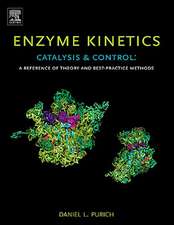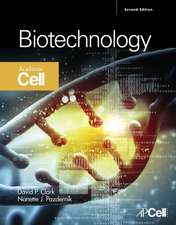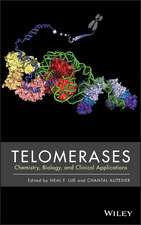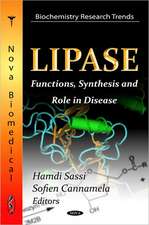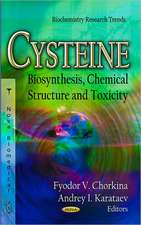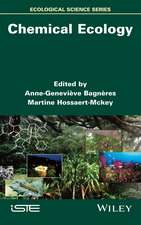Enzyme Kinetics and Mechanism, Part F: Detection and Characterization of Enzyme Reaction Intermediates: Methods in Enzymology, cartea 354
Autor Daniel L. Purichen Limba Engleză Hardback – 4 noi 2002
- Spectroscopic Detection of Reaction Intermediates
- Isotopic and Kenetic Detection of Reaction Intermediates
- Chemical Trapping and Inhibitor Methods for Detecting Reaction Intermediates
Din seria Methods in Enzymology
- 28%
 Preț: 801.23 lei
Preț: 801.23 lei - 32%
 Preț: 802.54 lei
Preț: 802.54 lei - 23%
 Preț: 461.36 lei
Preț: 461.36 lei - 23%
 Preț: 460.60 lei
Preț: 460.60 lei - 23%
 Preț: 439.86 lei
Preț: 439.86 lei - 23%
 Preț: 448.15 lei
Preț: 448.15 lei - 23%
 Preț: 451.42 lei
Preț: 451.42 lei - 23%
 Preț: 445.18 lei
Preț: 445.18 lei - 5%
 Preț: 557.15 lei
Preț: 557.15 lei - 23%
 Preț: 450.67 lei
Preț: 450.67 lei - 23%
 Preț: 446.23 lei
Preț: 446.23 lei - 23%
 Preț: 435.87 lei
Preț: 435.87 lei - 23%
 Preț: 445.94 lei
Preț: 445.94 lei - 23%
 Preț: 459.55 lei
Preț: 459.55 lei - 23%
 Preț: 460.02 lei
Preț: 460.02 lei - 23%
 Preț: 456.61 lei
Preț: 456.61 lei - 23%
 Preț: 450.54 lei
Preț: 450.54 lei - 23%
 Preț: 453.47 lei
Preț: 453.47 lei - 5%
 Preț: 565.37 lei
Preț: 565.37 lei - 23%
 Preț: 450.67 lei
Preț: 450.67 lei - 23%
 Preț: 464.33 lei
Preț: 464.33 lei - 23%
 Preț: 441.49 lei
Preț: 441.49 lei - 23%
 Preț: 447.44 lei
Preț: 447.44 lei - 23%
 Preț: 459.13 lei
Preț: 459.13 lei - 23%
 Preț: 450.38 lei
Preț: 450.38 lei - 23%
 Preț: 445.80 lei
Preț: 445.80 lei - 23%
 Preț: 445.35 lei
Preț: 445.35 lei - 23%
 Preț: 442.53 lei
Preț: 442.53 lei - 23%
 Preț: 450.38 lei
Preț: 450.38 lei - 23%
 Preț: 448.60 lei
Preț: 448.60 lei - 23%
 Preț: 447.57 lei
Preț: 447.57 lei - 23%
 Preț: 458.97 lei
Preț: 458.97 lei - 23%
 Preț: 440.90 lei
Preț: 440.90 lei - 23%
 Preț: 448.15 lei
Preț: 448.15 lei - 23%
 Preț: 466.84 lei
Preț: 466.84 lei - 23%
 Preț: 451.42 lei
Preț: 451.42 lei - 23%
 Preț: 453.64 lei
Preț: 453.64 lei - 23%
 Preț: 459.13 lei
Preț: 459.13 lei - 23%
 Preț: 457.49 lei
Preț: 457.49 lei - 23%
 Preț: 447.44 lei
Preț: 447.44 lei - 5%
 Preț: 561.34 lei
Preț: 561.34 lei - 23%
 Preț: 447.57 lei
Preț: 447.57 lei - 23%
 Preț: 453.35 lei
Preț: 453.35 lei - 23%
 Preț: 441.95 lei
Preț: 441.95 lei - 23%
 Preț: 450.38 lei
Preț: 450.38 lei - 23%
 Preț: 449.19 lei
Preț: 449.19 lei - 23%
 Preț: 456.02 lei
Preț: 456.02 lei - 23%
 Preț: 455.11 lei
Preț: 455.11 lei - 23%
 Preț: 455.87 lei
Preț: 455.87 lei
Preț: 1241.79 lei
Preț vechi: 1701.08 lei
-27% Nou
Puncte Express: 1863
Preț estimativ în valută:
237.62€ • 248.72$ • 197.77£
237.62€ • 248.72$ • 197.77£
Carte tipărită la comandă
Livrare economică 31 martie-14 aprilie
Preluare comenzi: 021 569.72.76
Specificații
ISBN-13: 9780121822576
ISBN-10: 0121822575
Pagini: 650
Dimensiuni: 152 x 229 x 27 mm
Greutate: 0.84 kg
Editura: ELSEVIER SCIENCE
Seria Methods in Enzymology
ISBN-10: 0121822575
Pagini: 650
Dimensiuni: 152 x 229 x 27 mm
Greutate: 0.84 kg
Editura: ELSEVIER SCIENCE
Seria Methods in Enzymology
Public țintă
Biochemists, biophysicists, pharmacologists, molecular biologists, analytical, organic, and medicinal chemists, and graduate students in these disciplinesCuprins
Covalent Enzyme-Substrate Compounds: Detection and Catalytic Competence.
Rapid Mix-Quench MALDI-TOF Mass Spectrometry for Analysis of Enzymatic Systems.
Pre-Steady-State Kinetics of Enzymatic Reactions Studied by Electrospray Mass Spectrometry with On-Line Rapid-Mixing Techniques.
Trapping of -Glycosidase Intermediates.
Trapping Covalent Intermediates on ß-Glycosidases.
2-Hydroxy-6-keto-nona-2,4-diene 1,9-Dioic Acid 5,6-Hydrolase: Evidence from18O Isotope Exchange for gem-Diol Intermediate.
Nucleoside-Diphosphate Kinase: Structural and Kinetic Analysis of Reaction Pathway and Phosphohistidine Intermediate.
Galactose-1-Phosphate Uridylyltransferase: Kinetics of Formation and Reaction of Uridylyl-Enzyme Intermediate in Wild-Type and Specifically Mutated Uridylyltransferases.
Kinetic Evidence for Covalent Phosphoryl-Enzyme Intermediate in Phosphotransferase Activity of Human Red Cell Pyrimidine Nucleotidases.
Characterization of (2->6) -Sialyltransferase Reaction Intermediates: Use of Alternative Substrates to Unmask Kinetic Isotope Effects.
Use of Sodium Borohydride to Detect Acyl-Phosphate Linkages in Enzyme Reactions.
Evidence for Phosphotransferases Phosphorylated on Aspartate Residue in N-Terminal DXDX(T/V) Motif.
MurC and MurD Synthetases of Peptidoglycan Biosynthesis: Borohydride Trapping of Acyl-Phosphate Intermediates.
Transaldolase B: Borohydride Reduction Trapping of Schiff Base Intermediate between Dihydroxyacetone and -Amino Group of Active-Site Lysine Residue.
Use of NMR and Borohydride Trapping to Provide Evidence for Covalent Enzyme-Substrate Imine Intermediate.
Detection of Covalent Tetrahedral Adducts by Differential Isotope Shift ¹³C NMR: Acetyl-Enzyme Reaction Intermediate Formed by 3-Hydroxy-3-methylglutaryl-CoA Synthase.
Detection of Intermediates in Reactions Catalyzed by PLP-Dependent Enzymes: O-Acetylserine Sulfhydrylase and Serine-Glyoxalate Aminotransferase.
Protein Tyrosine Phosphatase: X-Ray Crystallographic Observation of Cysteinyl-Phosphate Reaction Intermediate.
GTP:GTP Guanylyltransferase: Trapping Procedures for Detecting and Characterizing Chemical Nature of Enzyme-Nucleotide Phosphoramidate Reaction Intermediate.
-Glutamyl Thioester Intermediate in Glutaminase Reaction Catalyzed by Escherichia coli Asparagine Synthetase B.
-Glutamyltranspeptidase and -Glutamyl Peptide Ligases: Fluorophosphonate and Phosphonodifluoromethyl Ketone Analogs as Probes of Tetrahedral Transition State and -Glutamyl-Phosphate Intermediate.
Stoichiometric Redox Titrations of Complex Metalloenzymes.
Urate Oxidase: Single-Turnover Stopped-Flow Techniques for Detecting Two Discrete Enzyme-Bound Intermediates.
Nitric Oxide Synthase: Use of Stopped-Flow Spectroscopy and Rapid-Quench Methods in Single-Turnover Conditions to Examine Formation and Reactions of Heme- O2 Intermediate in Early Catalysis.
Myeloperoxidase: Kinetic Evidence for Formation of Enzyme-Bound Chlorinating Intermediate.
Time-Resolved Resonance Raman Spectroscopy of Intermediates in Cytochrome Oxidase.
Porphobilinogen Deaminase: Accumulation and Detection of Tetrapyrrole Intermediates Using Enzyme Immobilization.
Adenosylcobalamin-Dependent Glutamate Mutase: Pre-Steady-State Kinetic Methods for Investigating Reaction Mechanism.
Ribonucleotide Reductase: Kinetic Methods for Demonstrating Radical Transfer Pathway in Protein R2 of Mouse Enzyme in Generation of Tyrosyl Free Radical.
Galactose Oxidase: Probing Radical Mechanism with Ultrafast Radical Probe.
Kinetic Characterization of Transient Free Radical Intermediates in Reaction of Lysine 2,3-Aminomutase by EPR Lineshape Analysis.
Demonstration of Peroxodiferric Intermediate in M-Ferritin Ferroxidase Reaction Using Rapid Freeze-Quench Mössbauer, Resonance Raman, and XAS Spectroscopies.
A Survey of Covalent, Ionic, and Radical Intermediates in Enzyme-Catalyzed Reactions.
Recenzii
PRAISE FOR THE SERIES
"The Methods in Enzymology series represents the gold-standard." --NEUROSCIENCE
"Incomparably useful." --ANALYTICAL BIOCHEMISTRY
"It is a true 'methods' series, including almost every detail from basic theory to sources of equipment and reagents, with timely documentation provided on each page." --BIO/TECHNOLOGY
"The series has been following the growing, changing and creation of new areas of science. It should be on the shelves of all libraries in the world as a whole collection." --CHEMISTRY IN INDUSTRY
"The appearance of another volume in that excellent series, Methods in Enzymology, is always a cause for appreciation for those who wish to successfully carry out a particular technique or prepare an enzyme or metabolic intermediate without the tiresome prospect of searching through unfamiliar literature and perhaps selecting an unproven method which is not easily reproduced." --AMERICAN SOCIETY OF MICROBIOLOGY NEWS
"If we had some way to find the work most often consulted in the laboratory, it could well be Colowick and Kaplan's multi-volume series Methods in Enzymology...a great work." --ENZYMOLOGIA
"A series that has established itself as a definitive reference for biochemists." --JOURNAL OF CHROMATOGRAPHY
"The Methods in Enzymology series represents the gold-standard." --NEUROSCIENCE
"Incomparably useful." --ANALYTICAL BIOCHEMISTRY
"It is a true 'methods' series, including almost every detail from basic theory to sources of equipment and reagents, with timely documentation provided on each page." --BIO/TECHNOLOGY
"The series has been following the growing, changing and creation of new areas of science. It should be on the shelves of all libraries in the world as a whole collection." --CHEMISTRY IN INDUSTRY
"The appearance of another volume in that excellent series, Methods in Enzymology, is always a cause for appreciation for those who wish to successfully carry out a particular technique or prepare an enzyme or metabolic intermediate without the tiresome prospect of searching through unfamiliar literature and perhaps selecting an unproven method which is not easily reproduced." --AMERICAN SOCIETY OF MICROBIOLOGY NEWS
"If we had some way to find the work most often consulted in the laboratory, it could well be Colowick and Kaplan's multi-volume series Methods in Enzymology...a great work." --ENZYMOLOGIA
"A series that has established itself as a definitive reference for biochemists." --JOURNAL OF CHROMATOGRAPHY

